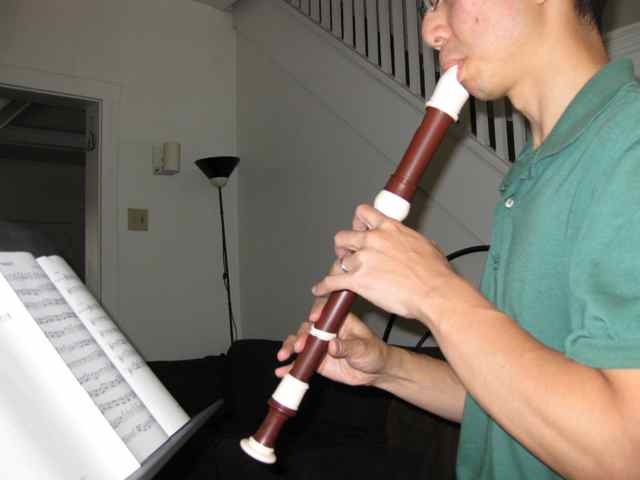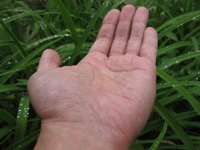A Musician's Best Friend

On June 1 this year, just over three months since first starting to play the alto recorder, I made a new friend who has helped me considerably with my musical practice, my improvement, my motivation. My best friend is steadfast, objective, non-judgmental, and always there for me; never complaining, never tired of pointing out where I need to improve and when I am ready to progress to the next level. This friend even makes challenges fun and addictive!
Who is this amazing friend of mine?
Meet my favorite metronome:
![]()
I have a bunch of different metronomes, but the one I use most is actually a free Mac OS application. I usually practice these days near my laptop, so that I can use this metronome program and conveniently change the tempo and volume.
I can’t believe I never used a metronome until June 1 this year!
Well, I had my reasons. One was that I was still traumatized by memories of old mechanical metronomes, the ones with swinging arms that clicked loudly and harshly. It was also not so convenient to change the tempo, and the fixed increments did not allow for fine adjustments in tempo. But mostly, I had the stubborn, “romantic” idea that metronomes were “robotic” and would encourage “soulless” playing rather than the “expressive” playing I have always idealized and aspired to.
Digital metronomes remove the limitations of the mechanical ones, of course.
But aren’t they still fundamentally robotic?
Why I started using the metronome
In May this year, it became harder and harder for me to gauge exactly how much I was improving when practicing exercises and pieces, because I didn’t know exactly how fast I was able to play passages without stumbling, and in my music log, comments such as “played exercise 27 better than yesterday” were losing their meaning. For the first three months of play, improvement was so fast that I didn’t need more precise self-assessment, but then when no longer playing easy stuff, I needed fine-tuned practice.
I started using the metronome app and started recording each day the fastest tempo at which I could play an exercise “honestly”: without terrible execution, missed notes, squeaky notes, etc. This was quite humbling. I learned that to actually completely get an exercise right, I often had to go at a much slower tempo than I had thought initially I could handle. In fact, I was so humbled that I was tempted many times to “cheat”, by recording in my music log a tempo faster than I could really handle! The temptation is always there.
Examples
Since late June, I have been working through “The Charlton Method for the Recorder: A Manual for the Advanced Recorder Player”, a very challenging method recommended on a very useful list of recorder methods. I used it to start learning the C-based recorders (soprano and tenor), after first getting the F-based alto to a sufficiently stable proficiency in four months (using other methods).
Exercise 36 in the Charlton method is a little piece in D major that I started working on in June. Here is my progression of metronome tempo:
- June 28 (120)
- July 1 (126)
- July 2 (132)
- July 3 (138)
- July 4 (144)
- September 3 (148)
- September 4 (150)
- September 5 (160)
- September 8 (164)
- September 29 (168)
As you can see, there are gaps in time during which I either did not practice this particular exercise or did not make progress worth noting. That is intentional. I learned through trial and error that sometimes I get stuck and it’s best to move on and try to improve at some other exercise (after all, there are hundreds of exercises I work on, and time is limited), or, now that I am practicing soprano, alto, tenor, and bass, a different instrument to work on for a while. Being stuck is time wasting and morale crushing, so when I am genuinely stuck (as opposed to just lazy or ineffective), I move on.
Another example is exercise 51, which I found very frustrating for a long period of time, during which I felt I was stagnating and needed to master this exercise eventually:
- June 30 (120)
- September 3 (126)
- September 4 (128)
- September 5 (132)
- September 8 (133)
- September 26 (134)
- September 27 (135)
- September 29 (137)
Recently I have been making real progress on this exercise. During all of July, every time I visited this exercise, I ended up stumbling sufficiently badly that I felt it wise to do something else. Note how useful it is to be able to click the Mac app metronome to increase the tempo by just one beat per minute (the app also supports fractional increases, but I have not felt the need to use that level of granularity).
Here’s exercise 66G, for alto, that I’ve been finding surprisingly tricky to improve further on:
- September 2 (62)
- September 3 (74)
- September 4 (88)
- September 8 (91)
- September 10 (114)
- September 26 (115)
- September 28 (116)
Note that sometimes there are jumps. These happen for two reasons. One is that often, when first attempting an exercise, I am very slow, and therefore I improve quickly from the initial attempt. The other is that sometimes I am stuck at just one particular section of an exercise, and I am already able to play the rest of it much faster, but just not that one section. Once that one section falls into place, then all is good.
The numbers are particularly amusing when just learning a new instrument, of course. I started learning the bass recorder only last week (I borrowed it from someone to try out, and this week I ordered a new one for myself that I expected to receive on Monday). The trickiest thing about the bass recorder is that you have to read the music off bass clef. (Also, there are some alternate fingerings, such as for E-flat, that are required for this Yamaha bass.) So the past week has been mainly getting my fingers and brain matching up with bass clef reading. Exercise 3 in Charlton for bass recorder:
- September 20 (92)
- September 22 (106)
- September 24 (110)
- September 25 (130)
I rather enjoying using the metronome. It “gamifies” my music practice, giving me concrete and reliable goals for improving technique for speedy and stable execution of notes.
Conclusion
There is nothing “romantic” about avoiding the use of a metronome to improve one’s skill at playing an instrument, but it is actually relieving to have a steady friend who can keep you on track while you try to master the elements of playing so that you can eventually play expressively and beautifully. The metronome is a means to the goal. Just because there is huge amount of help the metronome is not able to give (improving tone, breathing, dynamics, rubato, phrasing are of course part of my practice as well!) does not mean that it does not have a place in a serious amateur’s practice.

Awesome post! Your digital metronome technique reminds me of my idea to incorporate progressively shorter time limits in which to complete each drawing.